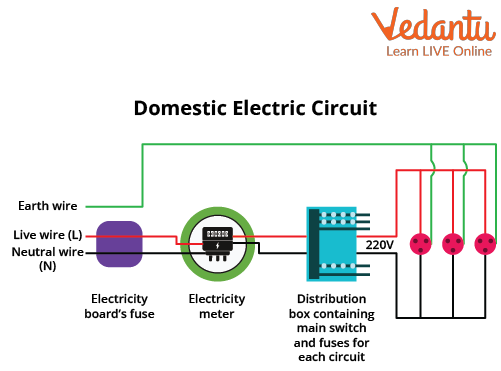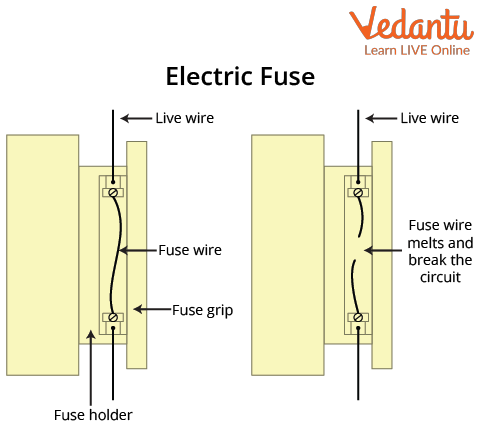




Domestic Electric Circuit Diagram with Parts and Functions
A domestic electric circuit is the system of electrical wiring that distributes power throughout a home, enabling the operation of everyday devices safely and efficiently. Understanding its components, arrangement, and protection mechanisms is essential for JEE Main Physics and is rooted in the fundamentals of current electricity and circuit behavior. Domestic circuits link the main supply to lights, fans, and heavy appliances—making their design a real-world application of basic electrical laws.
Domestic Electric Circuit Diagram and Structure
In a typical Indian household, the domestic electric circuit starts at the main supply and incorporates devices for measurement, protection, and distribution. Clarity in drawing and labeling is critical for exam answers, and understanding the flow of electric current across connected appliances is a high-frequency JEE topic.

A labelled domestic electric circuit diagram features the main fuse, energy meter, main switch (usually a double-pole), miniature circuit breakers (MCBs), neutral and earth wires, and parallel branches for lighting and power sockets. Wires are color-coded for phase (red/brown), neutral (black/blue), and earth (green/yellow).
Components of a Domestic Electric Circuit
Every domestic electric circuit includes several key elements designed for both operation and user safety. Their arrangement directly affects household protection against faults and overloads.
- Main Fuse: Protects the entire home by melting if excess current flows. Acts as a primary safeguard against short circuits.
- Energy Meter: Measures total electrical energy consumed in kilowatt-hours (kWh).
- Main Switch/Double Pole Switch: Disconnects both phase and neutral, isolating the circuit during faults or maintenance.
- MCB (Miniature Circuit Breaker): Trips and disconnects supply during overload or short circuit—resettable and safer than fuses.
- Distribution Board: Splits supply into separate circuits for lights (5A) and power appliances (15A).
- Earthing Wire: Provides low-resistance path to ground, preventing accidental shocks.
- Switches/Sockets: Allow controlled connection of appliances to the circuit.
- Appliances (Lamps, Fans, Heaters): Connected in parallel for independent operation.
AC vs DC in Domestic Electric Circuits
India’s domestic electric circuit uses alternating current (AC), typically 230 V at 50 Hz. This choice is practical for cost-effective, long-distance transmission and compatibility with transformers, unlike DC, which cannot be stepped up or down efficiently. AC’s periodic reversal does not affect most common appliances but can be hazardous in case of faulty wiring, making robust protection vital.
| Feature | AC (Domestic) | DC |
|---|---|---|
| Typical Usage | Homes, offices | Batteries, electronics |
| Voltage Level | 230 V | Varies (1.5–24 V) |
| Transmission Loss | Low with step-up/step-down | High for long distance |
| Appliance Compatibility | Most home appliances | DC motors, gadgets |
Series vs Parallel in Domestic Electric Circuits
All household appliances in a domestic electric circuit are connected in parallel rather than series. This arrangement allows each device to receive the same voltage and be operated independently—switching one does not affect the others.
| Wiring Principle | Series | Parallel |
|---|---|---|
| Current Through Each | Same | May differ |
| Voltage Across Each | Divided | Same as main supply |
| Effect of Appliance Removal | All turn off | Others unaffected |
| Home Application | Never used | Standard |
For more, see difference between series and parallel circuits and parallel and mixed grouping of cells.
5A and 15A Circuits: Need and Application
A crucial detail in the domestic electric circuit is the division into two types of sub-circuits:
- 5A circuit: For low-power devices—lights, fans, TVs, mobile chargers. Uses thin wires, has 5A-rated switches and sockets.
- 15A circuit: For high-power devices—heaters, air conditioners, geysers, refrigerators, microwaves. Uses thicker wires; sockets and plugs are robust and three-pinned.
This division minimizes overload and localizes faults. Each circuit has its dedicated protection (MCB/fuse) in the distribution board.
Safety Features in Domestic Electric Circuits
Safety in home wiring depends on the inclusion and proper functioning of devices like fuses, MCBs, and earthing. These prevent electric shocks, fire hazards, and appliance damage.

- Fuse: A thin wire of low melting point, breaks circuit when current exceeds safe value.
- MCB: Automatic circuit breaker, offers quick isolation and reset after overload.
- Earthing: Connects exposed metal parts to the earth, draining fault currents and preventing shock.
Proper earthing is mandated by electrical code. Poor earthing or missing ground in sockets is a key pitfall students must recognize for both exams and safe practice.
Numerical Example: Current Calculation in Domestic Electric Circuit
Suppose a 1.5 kW geyser (230 V rating) is connected to a 15A power socket. Find the current through the geyser, and check if a 15A circuit is sufficient.
- Given: Power P = 1.5 × 103 W, Voltage V = 230 V
- By Ohm’s Law: I = P / V = 1500 / 230 = 6.52 A
- Since 6.52 A < 15 A, the circuit can safely handle the load.
For more examples and theory, refer to resistance, Ohm’s law, and electric power and energy pages.
Quick Recap: Domestic Electric Circuit Essentials
| Term | Key Point |
|---|---|
| Supply Type | AC, 230 V, 50 Hz, India |
| Wiring Scheme | Parallel for all appliances |
| Protection | MCB, fuse, earthing |
| 5A circuit | Low power (lights, fans, TV) |
| 15A circuit | High power (AC, geyser) |
| Common Pitfall | Missing earthing; overloading sockets |
Mastering domestic electric circuit theory enables you to confidently solve JEE Main numericals and avoids confusion about wiring practice, protection, and real-world application. Practise more with how to solve any electric circuit and current electricity practice questions. Vedantu provides up-to-date concept explanations according to the latest exam patterns to help you succeed in JEE Main Physics.
FAQs on Domestic Electric Circuit – Definition, Diagram, and Explanation
1. What is a domestic electric circuit?
Domestic electric circuit refers to the wiring system in homes that safely distributes electric current from the mains supply to all appliances and sockets.
Key points include:
- Supplies AC (alternating current) to household devices.
- Comprises protective devices like fuse or MCB, meter, and earthing for safety.
- Connects all lights, fans, and appliances via parallel wiring for independent functioning.
2. Is a domestic electric circuit AC or DC?
Domestic electric circuits use AC (alternating current) supplied by power stations.
This is because:
- AC can be easily transmitted over long distances with less energy loss.
- Household appliances are designed for the standard AC voltage (typically 230V, 50Hz in India).
- Using AC enables more efficient and safe operation in homes.
3. Why do we use parallel circuits in domestic electric circuits?
Parallel circuits are used in homes so each appliance receives full voltage and operates independently.
- If one device fails, others continue to work.
- Each appliance can be switched on/off without affecting others.
- Voltage across each branch remains the same, ensuring safety and convenience.
4. What are the main components of a domestic electric circuit?
Key components of a domestic electric circuit include:
- Main fuse or MCB – for overcurrent protection.
- Electric meter – measures electricity usage.
- Main switch – for shutting off supply to the house.
- Earthing wire – safety against electric shocks.
- Wires – carry current to different parts of the house.
- Sockets and switches – for plugging appliances and controlling flow.
5. What is the need for 15A and 5A circuits in the domestic circuit?
Homes have both 5A and 15A circuits to handle devices of different power ratings.
- 5A circuits are for low-power appliances (bulbs, fans, TVs).
- 15A circuits are for high-power appliances (water heaters, ACs, refrigerators).
- This ensures safety and prevents overloading or overheating of wires.
6. How do you draw a domestic electric circuit diagram for class 10?
To draw a domestic electric circuit diagram for class 10:
- Start with mains supply entering the house.
- Show the main fuse or MCB and electric meter.
- Draw the main switch, then split the circuit into 5A and 15A branches.
- Include sockets, appliances, earthing wire, and proper labels.
- Neat, labelled diagrams with standard symbols fetch full marks.
7. What is the role of fuse, MCB, and earthing in home circuits?
The fuse, MCB (Miniature Circuit Breaker), and earthing provide essential safety in home circuits.
- Fuse: Breaks the circuit in case of excess current, preventing fire.
- MCB: Automatically switches off during overload or faults, is reusable.
- Earthing: Prevents electric shocks by providing a safe path for leakage current to the ground.
8. Can a blown fuse damage electrical appliances at home?
A blown fuse typically protects appliances by stopping power flow in case of overload or short circuit.
- Prevents damage due to excess current.
- Once blown, circuit is incomplete until the fuse is replaced.
- Immediate replacement with the correct rating is important for continued protection.
9. What will happen if the household electricity circuit is connected in series instead of parallel?
Connecting household circuits in series would cause several problems:
- All appliances share the same current, so switching off one stops all devices.
- Appliances may not receive required voltage, affecting performance.
- Whole circuit fails if one appliance fails, making parallel wiring essential for usability.
10. How does a circuit breaker provide better safety than a fuse?
Circuit breakers (like MCBs) offer better safety than traditional fuses:
- They can be reset and reused, unlike fuses which need replacement after blowing.
- React faster and more reliably to overcurrent situations.
- Allow easy identification and correction of faulty circuits.
11. Why is earthing important in a domestic electric circuit?
Earthing protects people and property by providing a low-resistance path for fault current.
- Prevents electric shocks from leakage or faulty appliances.
- Ensures excess current safely dissipates into the ground.
- Is a mandatory safety feature in modern home wiring systems.
12. What are the standard wiring color codes used in domestic electric circuits?
Domestic wiring color codes ensure safety and standardization:
- Live wire: Red or brown
- Neutral wire: Black or blue
- Earth (earthing) wire: Green or green-yellow
- Knowing these colors helps avoid connection mistakes.


















